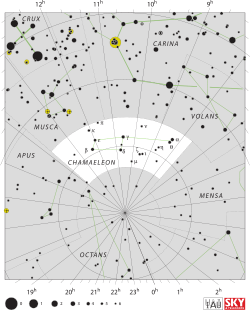Iota Chamaeleontis
 | |
| Observation data Epoch J2000 Equinox J2000 | |
|---|---|
| Constellation | Chamaeleon |
| Right ascension | 09h 24m 09.22492s[1] |
| Declination | −80° 47′ 12.7567″[1] |
| Apparent magnitude (V) | 5.36[2] |
| Characteristics | |
| Spectral type | F3/5 III/V[2] |
| U−B color index | +0.01[3] |
| B−V color index | +0.445[3] |
| Astrometry | |
| Radial velocity (Rv) | 7.00[4] km/s |
| Proper motion (μ) | RA: -138.46[1] mas/yr Dec.: 135.06[1] mas/yr |
| Parallax (π) | 17.20 ± 0.20[1] mas |
| Distance | 190 ± 2 ly (58.1 ± 0.7 pc) |
| Absolute magnitude (MV) | +1.32[5] |
| Details | |
| Temperature | 6272[5] K |
| Metallicity [Fe/H] | -0.04[6] dex |
| Rotational velocity (v sin i) | 129.7[5] km/s |
| Other designations | |
| Database references | |
| SIMBAD | data |
Iota Chamaeleontis (ι Cha, ι Chamaeleontis) is a star in the constellation Chamaeleon. It has an apparent magnitude of about 5.3, meaning that it is just barely visible to the naked eye. Based upon parallax measurements made by the Hipparcos spacecraft, this star is around 190 light years away from the Sun.[1] Its spectral type is F3/5 III/IV, meaning it is an F-type star, likely a subgiant;[7] its proper motion is relatively high.[2]
References
- 1 2 3 4 5 6 van Leeuwen, F. (2007). "Validation of the new Hipparcos reduction". Astronomy and Astrophysics. 474 (2): 653–664. arXiv:0708.1752. Bibcode:2007A&A...474..653V. doi:10.1051/0004-6361:20078357.
- 1 2 3 4 "iot Cha". SIMBAD. Centre de données astronomiques de Strasbourg. Retrieved 25 January 2016.
- 1 2 Mermilliod, J.-C. (1986). "Compilation of Eggen's UBV data, transformed to UBV (unpublished)". Bibcode:1986EgUBV........0M.
- ↑ Gontcharov, G. A. (2006). "Pulkovo Compilation of Radial Velocities for 35 495 Hipparcos stars in a common system". Astronomy Letters. 32 (11): 759–771. arXiv:1606.08053. Bibcode:2006AstL...32..759G. doi:10.1134/S1063773706110065. Retrieved 12 December 2016.
- 1 2 3 Reiners, A. (January 2006). "Rotation- and temperature-dependence of stellar latitudinal differential rotation". Astronomy and Astrophysics. 446 (1): 267–277. arXiv:astro-ph/0509399. Bibcode:2006A&A...446..267R. doi:10.1051/0004-6361:20053911.
- ↑ Nordström, B.; et al. (2004). "The Geneva-Copenhagen survey of the Solar neighbourhood. Ages, metallicities, and kinematic properties of ˜14 000 F and G dwarfs". Astronomy and Astrophysics. 418: 989–1019. arXiv:astro-ph/0405198. Bibcode:2004A&A...418..989N. doi:10.1051/0004-6361:20035959.
- ↑ Allen, J. S. "The Classification of Stellar Spectra". UCL Department of Physics and Astronomy: Astrophysics Group. Retrieved 1 January 2014.
This article is issued from
Wikipedia.
The text is licensed under Creative Commons - Attribution - Sharealike.
Additional terms may apply for the media files.